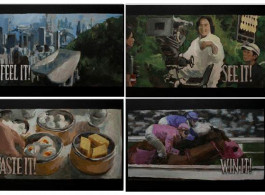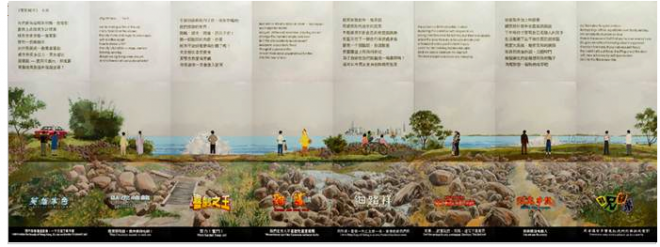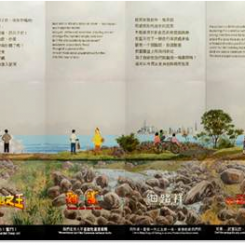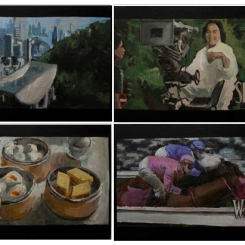Opening Reception with Artist
Friday 13th September 2013, 6pm – 8 pm
(Exhibition until 8 October, 2013 )
‘I Have Something to Say’ brings to us four sets of new works by Chow Chun Fai. The first new work comes from a collaboration between Chow and the late poet, Leung Ping Kwan. Leung wrote a poem for Chow’s paintings, which carries the poet’s typical style of distilling poetics from the most mundane language, and Chow responded by a further symbolized version of his film paintings — film titles with original graphics, the protagonists with their backs towards us, and classic lines. In addition to Leung’s poem, this long format looks just like a folded leaflet of a Hong Kong film retrospective, but not a painting! The second new work is a project Chow made for the Liverpool Biennial last year, in which he repainted a television ad that promotes tourism in Hong Kong — its point being to further virtualize something that is already made up and fictional. The project reminds us of Brecht’s strategy to deal with the “ideological glue”, that is, to read through ideological texts with the greatest care, to embrace the stickiness in order to loosen up. The third set of paintings are related to Chow’s participation in last year’s Legislative Council elections representing the art field, in which he continued his investigation into the interaction between artistic practices and socio-political engagements. The fourth new work is at first glance another film painting, but what is on the picture is actually a staged drama instead of a film. It is ‘Red’, a story about the painter Mark Rothko. Interestingly, after dedicating nearly two full years to an election and other forms of public services, Chow, in borrowing from this drama, is now making this somewhat conclusive statement: “We have Art in order we may not perish from Truth.”
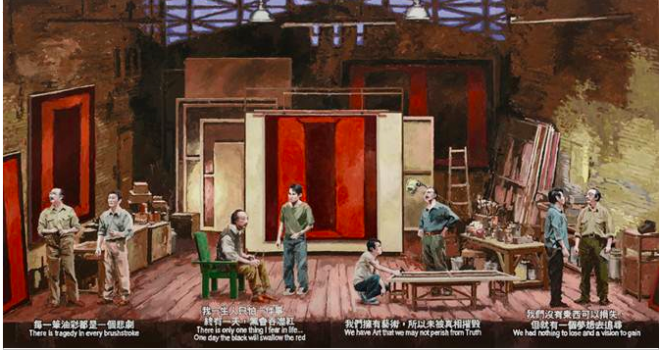
RED , “We have Art that we may not perish from Truth” , 紅 -「我們擁有藝術,所以未被真相摧毀」,
2013, Enamel paint on Canvas, 150 x 280 cm
In 1964, Gerhard Richter wrote, “Pictures which are interpretable, and which contain a meaning, are bad pictures. A picture presents itself as the Unmanageable, the Illogical, the Meaningless.” He seemed to be saying that contemporary painting is destined to refuse meanings, to avoid anything close to precision and concreteness. It has to equivocate, to say what it has to say, circuitously. However, what is particularly notable about Chow Chun Fai’s paintings is the deliberate clarity of their messages — Chow never disguises what he wants to say. In this way, he is against fashion. There are ironies and complaints, there are witty ideas that make you chuckle, but his paintings are always “righteous”. His paintings are unambiguous. His standpoints are clear; his core values are constantly being reaffirmed.

Reproducing “Hong Kong – Live it, Love it!” (details), 重組「香 港 – 樂在此, 愛在此!」(局部),
2012, Acrylic on Canvas, Video, Dimension variable
For Chow, painting is a kind of ‘Kung Fu’, that is, an everyday practice that requires long periods of repetitive training. He does not believe that an artist can create something completely new in a painting. Instead, paintings should act as a mirror to reflect the different faces of reality, a trigger of memories, a still from the endless stream of pictures. When he transforms texts that represent our collective memories or experiences from real life into paintings, the hierarchical relationship must be this: not that memories and experiences serve as the resources with which to form paintings, but rather that to paint is a way to process the things obtained from life. This can help us to understand the specificity of Chow’s paintings — they are not attempts to condense the whole atmosphere of a scene onto a canvas, instead, they are happy to appropriate and make use of the indirectness of second hand images. It is not an immediate intuitive response for the artist, but the result of careful selection and research. He borrows “readymades” such as cinematic images and texts, adding different impurities into his paintings. Here, the purity of painting is not important.

